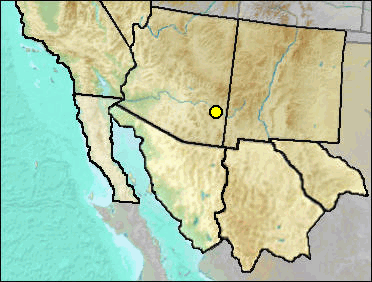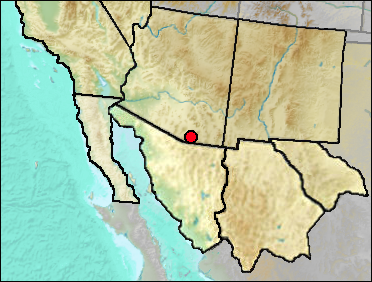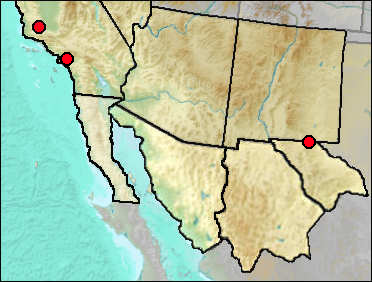Class Mammalia
Order Artiodactyla
Suborder Ruminantia
Family Cervidae
Bretzia sp.—False Elks // Cervus elaphus—Elk // Navahoceros fricki—Mountain Deer // Navahoceros lascrucensis—Las Cruces Mountain Deer // Odocoileus—Deer
Cervids are ruminants characterized in part by the males (and females in one species) having deciduous antlers that are shed and regrown yearly. As with horns, the structures emerge from the frontal bones; a permanent pedicel remains after the antler is shed. Cervids also differ from our regional antilocaprids and bovids in having brachyodont dentition. They generally are considered browsers rather than grazers, feeding on herbaceous material other than grasses.
Historically, Elk, Mule Deer, and White-tailed Deer occurred in our region. Elk were quickly hunted out of the central and southern portions of the region, but have been re-introduced in recent years, becoming a nuisance in some areas.

Sites.
Late Blancan: San Simon Fauna (Morgan and White 2005: cf.).
Literature.

Skinner (1942) reported Cervus sp. indet. from Papago Springs Cave, noting that it compared favorably with Cervus canadensis (=C. elaphus).
Sites.
Rancholabrean: Papago Springs Cave (Skinner 1942).
Literature. Skinner 1942.

Synonyms. Cervus merriami Nelson 1902. Anderson and Barlow (1978) compared this taxon with C. elaphus and concluded that it was a marginally valid subspecies of C. elaphus. Cervus canadensis may be valid as a separate species for North America and a portion of Asia.
Southern populations of Elk were named as a species separate from the more northern populations. They were soon extirpated by over-hunting, and relatively few specimens survive (Anderson and Barlow 1978). Current Elk populations in the region are from introductions from farther north.
Ayer (1936) referred a fragment of a large molar and the proximal end of an ulna to Cervus merriami. Regarding the ulna, she noted that it was "entirely too large for any Mule Deer and undoubtedly represents an immature Elk or Wapiti" (p. 612). It is unclear whether she was aware at the time of writing that Schultz and Howard (1935) had named a new species of cervid (Rangifer fricki) from Burnet Cave, though the publication dates suggest she was not. Rangifer fricki was said by Schultz and Howard to be intermediate in size between Odocoileus and Cervus. Thus there is a possibility that this species (currently known as Navahoceros fricki) is represented.
Sites.
?Late Irvingtonian/Rancholabrean: Emery Borrow Pit (Jefferson 1991b).
Mid Wisconsin: McKittrick (Jefferson 1991b: cf.).
Late Wisconsin/Holocene: Williams Cave (Ayer 1936).
Literature. Anderson and Barlow 1978; Ayer 1936; Jefferson 1991b.
Last Update: 13 Jul 2018